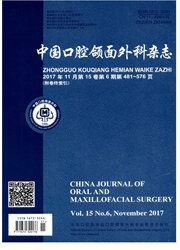

 中文摘要:
中文摘要:
目的:介绍一种改良颞下颌关节(temporomandibular joint,TMJ)盘锚固定术式。方法:自2011年7月—2012年3月,共对177例(232侧)TMJ内紊乱患者进行改良TMJ盘锚固术治疗。具体方法是将1颗锚固钉置于髁突后斜面下缘中份,用2根3—0尼龙线固定关节盘于锚固钉。所有患者手术前、后进行MRI检查,评估关节盘位置。对伴有咬合紊乱或牙列不齐的患者,术后行再定位猞板或正畸治疗。结果:手术后MRI显示,172例(226侧1关节为优;4例(4侧)关节为良;有效率达99.14%(230/232侧);仅有1例(2侧)为“差”,占0.86%(2/232侧),需再次行锚固术治疗。结论:改良关节盘锚固术是一种治疗中、晚期TMJ内紊乱的有效方法,其术式设计更为合理,但远期疗效有待进一步评价。
 英文摘要:
英文摘要:
PURPOSE: To introduce a modified anchor technique for internal derangement of temporomandibular joint (TMJ). METHODS: One hundred seventy-seven patients (232 TMJs) diagnosed as TMJ internal derangement (ID), through clinical examinations and MRI, were treated with a modified anchor technique from July 2011 to March 2012. The technique is mainly proposed for TMJ ID. The approach was to put an anchoring nail in the middle of the inclined surface, just below the posterior oblique surface of the condyle and use two 3-0 Nylon sutures to fix disc to the anchoring nail. Both preoperative and postoperative MRIs were taken to define the disc position. For patients with malocclusion or irregular dentition, reposition biting plate and orthodontic treatment were also conducted. RESULTS: Among 232 joints of postoperative MRIs, 226 joints (172 cases) were classified as excellent and 4 joints (4 cases) were good, only 2 joints (1 case) were poor which needed a second open surgery. The total effective rate was 99.14%. CONCLUSION: The modified procedure provided successful results in the treatment of TMJ ID. The design was more reasonable, but further clinical evaluation is necessary. Supported by Shanghai Leading Academic Discipline Project (S30206), Research Project of Shanghai Municipal Bureau of Health (2008160), Doctorate Foundation of the Ministry of Education of China (20090073110068), National Natural Science Foundation of Shanghai Municipality (10ZR1418200)and Shanghai Pujiang Talent Plan in 2011.
 同期刊论文项目
同期刊论文项目
 同项目期刊论文
同项目期刊论文
 期刊信息
期刊信息
